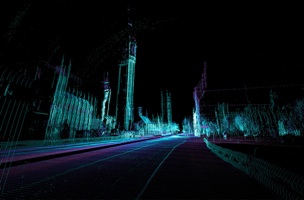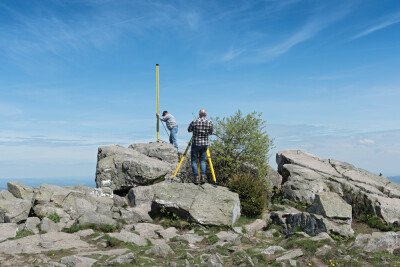By ScanLAB Projects for the New York Times Magazine.
Do Self-Driving Cars Dream of Point-Cloud Sheep?
This weekend, the New York Times is publishing a big story on LiDAR, complete with gorgeous pictures and a video or two. In a lot of ways, a feature story on LiDAR in the American “paper of record” represents the technology’s mainstream debut, the first time that many people in the US will hear about it.
Those of you from the US won’t be surprised to hear that the cause is cars–specifically self-driving cars that use LiDAR sensors to visualize and navigate their surroundings. The piece, by Geoff Manaugh of BLDGBLOG fame, asks a provocative question: How will the LiDAR sensors on self-driving vehicles change our cities?
There are a few fairly obvious ways. “Driver-controlled cars remade the world in the last century,” Manaugh explains, “and there is good reason to expect that driverless cars will remake it again in the century to come: Gridlock could become extinct as cars steer themselves along a cooperatively evolving lacework of alternative routes, like information traversing the Internet. With competing robot cars just a smartphone tap away, the need for street parking could evaporate, freeing up as much as a third of the entire surface area of some major American cities. And as distracted drivers are replaced by unblinking machines, roads could become safer for everyone.”
That’s not even the half of it, though. Consider this: Cities are currently designed to make it easy for human drivers to navigate. What will a city look like once we need to design them to make it easier for LiDAR sensors to navigate? These sensors see differently than we do–they’re flummoxed by reflective surfaces, fog, water, black, and so on. We know that a street sign is a good way to direct a human driver, but what’s a good way to direct a LiDAR sensor?
To figure that out, we’re going to have to think more about how LiDAR sensors see the world. “Understanding how driverless cars see the world,” Manaugh explains in a blog post, “also means understanding how they mis-see things: the duplications, glitches, and scanning errors that, precisely because of their deviation from human perception, suggest new ways of interacting with and experiencing the built environment.”
And that’s where ScanLAB Projects comes in. We’ve been keeping an eye on these guys for a while, and they’re the closest the LiDAR world has to full-on celebrities. Their project, which the NY Times gets into in depth, aims to mis-use laser scanners by forcing them to mess up for artistic purposes. It emphasizes those ways that the sensors “miss-see” things, and so it is a perfect way to create images of cities from a LiDAR sensor’s point of view.
It’s ghostly and beautiful, and it might be the future. Check it out at NYTimes Magazine.






